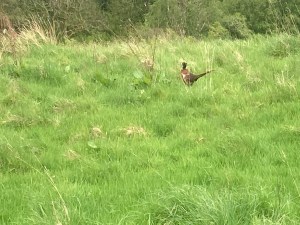Walking to Cape Wrath, Day 12, May 22, 2022
When I was a wee lad, my father taught me to make him a drink for his just-home-from-work relaxation. He drank Scotch whiskey (here, just whiskey) and my favorite glass to give him had a picture of a ring-necked pheasant etched on the side. I never knew what became of those glasses, but would love to have a set now. Today I was excited and surprised by running up on one in the bogs. After a bit more trekking, it became clear they were being bred in this area for the shooting class, but that did not diminish my pleasure seeing one break from the bracken on my approach.
Today was billed as an introduction to the highlands, and while probably tame compared with what awaits up near Cape Wrath, it was a rigorous introduction. It commenced with a fairly steep climb out of Callander to the “Crags” a geological formation I am sure is spectacular but only if visibility is more than 20 ft. The all night rain shower ceased well before my departure, but a heavy mist (that often approached rain) hung over the landscape until late morning. In many ways, today’s walk was a slight preview of what is to come: some fairly steep climbing, some trackless navigating, and a lot of mud and bog hiking. Much was in complete isolation (apart from the omnipresent sheep) passing abandoned houses and farms. There were lots of ice-age drumlins and so many small burns, rushing to join all that water in the valley.
A few moments stood out— at one point where I crossed some active farms, I was passed by a pickup with a smiling, happy older couple waving from the front seats while the back swarmed with black hound dogs. On crossing into their farm I passed a series of kennels built of the same stone as the houses, clearly of the same era—a classic working-dog breeding farm. Not long after that, I came up over a rise and saw on the road at a distance what I assumed was a small red dog. I looked for the human owner to appear on the road, but no one came. Then this “dog” stopped, obviously scenting me, turned and ran back down the road wagging a long, full red tail with white tip. As much of Scotland is being rewilded (if not always having been wild), encountering a fox should be no big deal, but it was a special moment.
Even though I finished mid afternoon in Comrie, the day felt longer than most—a lot more up and down, more refined navigation, added to how exhausting slogging in a bog can be. Bog hiking can take many forms. Today’s was of the deceptive field variety: you approach what looks to be a fairly rough pasture, only to discover the tall grass was growing in about 3 inches of running water. At first you look about for slightly higher ground to proceed, but then that unfortunately familiar sensation of cold water filling your shoes obviates all that, and instead you just plow ahead hoping it’s just one field and not a couple of kilometers.
Coming off the slope, I stopped at the Melville, a pub in Comrie, for a pint or two before catching a bus to Creiff where I had booked a room and, after a short visit to the Meadow Inn (wonderful pub, great staff), I slept like the dead.
T. Hugh Crawford











































